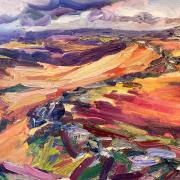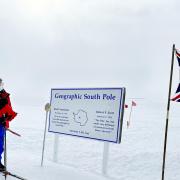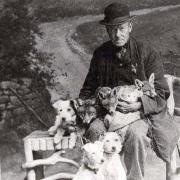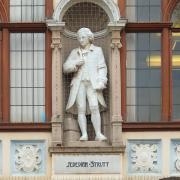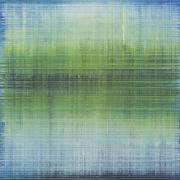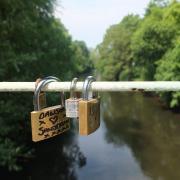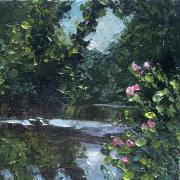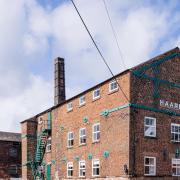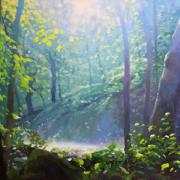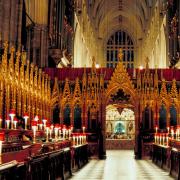Mike Smith meets Sue Prince, rural advocate, entrepreneur and artist
As well as attracting praise for her art work, Sue Prince has been called a ‘one-woman ideas factory’. She lives with her husband Terry at Beechenhill Farm, high above the Manifold Valley, where the couple run a multi-faceted business. Their superb website, which was designed, written and illustrated by Sue, has won an award as the ‘best tourism website in England’. It includes links to lots of committees that benefit from Sue’s membership. Some of these were established by her in the first instance and almost all of them are concerned with the welfare of people who live and work in rural areas.
Sensing that Sue’s art should not be considered in isolation from her other interests, I began our interview by asking her about her various activities. Responding without any trace of boasting but with boundless enthusiasm, she talked about her membership of numerous groups designed to help rural food producers, promote eco-tourism and tackle rural disadvantage; she enthused about the conversion of Beechenhill into an organic farm and its use as prize-winning accommodation and as a wedding venue; she spoke of her work as a Deputy Lieutenant of Staffordshire, described a visit by Prince Charles to the farm and recalled that she had worked for one of his charities in Transylvania.
Before visiting Sue’s studio, I was keen to probe the formative years of this ‘Renaissance Woman’. Recalling her childhood, she said: ‘I was born in London, but we lived all over the country for the next 15 years, simply because my father was very ambitious and was always seeking promotion. I attended eleven different schools and, being an only child until I reached secondary school age, I had to make new friends every time we moved. I would invariably seek out farming people because they always had a space around their kitchen table for an extra child.’
Encouraged by her mother, Sue joined the Young Farmers’ Club when she was living in the Staffordshire town of Eccleshall. ‘This was where I met Terry, who claims that he picked me out across a crowded room,’ she said. ‘We married in 1976 and subsequently had two children, Alexandra and Gabrielle. In 1984, we left Terry’s family farm in Marchington and moved with our young daughters to Beechenhill, because we had been bowled over by its spectacular location and had been charmed by the couple who were selling the place – they even gave us a puppy as a moving-in present.’
Before starting a family, Sue was employed in a drawing office for a computer firm, where she learned how to use a technical drawing pen, which she still uses in her art work. She had become aware of her artistic ability while she was at school and had even accepted several commissions at that time, often without knowing how to fulfil them but always determined that she would find ways of doing so – an attitude to every challenge, artistic or otherwise, that she has taken on throughout her life.
In the years when her daughters were growing up, Sue carried out commissions for trompe l’oeil murals, which she painted in situ, and for book illustrations, which she created in her studio at Beechenhill Farm. Her illustrative work comprised images for children’s books, particularly those written by Barbara Mitchelhill, and drawings for teaching materials aimed at children with learning difficulties. In addition, she designed stained glass for Ilam School, Tinsel Park School in Uttoxeter and Methodist churches at Eccleshall in Staffordshire and Church Broughton in Derbyshire. She also produced a number of paintings.
Given Sue’s obvious artistic skill, I was surprised to hear that she had been reluctant to have her pictures framed. When I probed her reasons, she paused for reflection for some minutes and then, as if realising the answer for the first time, said: ‘I suppose I felt that I was simply fulfilling commissions to earn a living and hadn’t found my own voice as an artist. I think I began to develop a distinctive style when I started doing embroidery, but it was my discovery of "Bonad painting" in 2004 that was the real breakthrough.’
Sue would not have come across the Swedish craft of Bonad painting but for her work as a tireless advocate for rural businesses. A Commissioner at the Commission for Rural Communities is one of her many important roles, but she is well known locally as the founder of Peak District Dairy Wagon, a mobile dairy processing facility which enables farmers to learn new skills, and the initiator of Peak District Foods, which promotes locally-sourced food. However, it was her membership of BESST (Business and Environment linked through Small Scale Tourism), a partnership linking the Peak with rural communities in Norway and Sweden, that took her to the village of Unnaryd, where she discovered Bonad.
Remembering the impact of her first sighting of the Bonad wall-hangings, which are produced by using egg-tempera (earth pigments in egg yolk) on gesso canvas and linen, she said: ‘The paintings reminded me of the Bayeux Tapestry and I could see that they were a way of allowing local people to tell their own tales through pictures and words. I immediately wanted to produce similar paintings, because I knew that I could use them to tell stories about the joy and difficulties of rural life.’
Having met the only surviving Bonad artist, Sue set to work on her own pictorial narratives. One of her early efforts celebrates the visit of the BESST group to Sweden and a picture called ‘Come up Rosie’ is a joyous image of Terry bringing in the cows for milking, but several other paintings are about the problems encountered by farmers. ‘Gathering Precious Things’ highlights the difficulties faced by milk producers because prices do not cover the cost of production and ‘Country Dreams’ suggests that the weight of paperwork imposed on farmers by urban government threatens to crush the rural dream.
However, Sue’s Bonads are not confined to rural issues: one picture illustrates the relationship between a miner and his pit pony; another work, which echoes Uccello’s paintings of medieval battles, depicts the Battle of Orgreave in the 1984 miners’ strike; and a split-level picture depicts the London riots, with City workers going about their business in ignorance of the strife affecting another level of society.
To discover more about Sue Prince’s art and to find out about opportunities for accommodation, events and weddings at Beechenhill Farm, visit
www.beechenhill.co.uk. Sue will be hosting an Open Studio at Beechenhill on 15th-16th and 22nd-23rd September.





